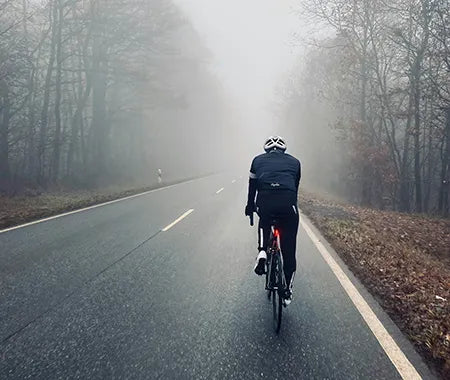Cycling in winter: 10 tips for cycling in ice and snow
For many people, cycling is a hobby they don't want to give up, even in winter. In fact, with the right preparation, it's easily possible to ride a bike even in low temperatures and snow. Cycling in winter even offers numerous benefits.
In this article, you'll learn why you should cycle in winter and how you can benefit from it. We've also compiled 10 tips to help you cycle safely in snowy and icy conditions. We'll also introduce you to our heated products that will keep you comfortably warm in low temperatures.
What are the benefits of cycling in winter?
Cycling in winter can give you more energy, strengthen your immune system and lift your mood.
Learn more1. Avoid uncleared bike paths
Uncleared cycle paths can be dangerous – it is therefore permitted to move onto the road.
Learn more2. Keep your upper body warm with a heated jacket
With a heated jacket, your upper body stays pleasantly warm while you ride.
Learn more3. Warm your hands with heated gloves
To prevent your hands from getting cold while cycling in winter, you should opt for heated gloves.
Learn moreWhat are the benefits of cycling in winter?
More and more people are getting on their bikes in the winter, too. Whether you're commuting to work or shopping, you can still use your bike in the winter and don't have to give it up. In fact, you can enjoy numerous benefits by cycling in cold temperatures.
We have summarized the biggest advantages for you:

You exercise in the fresh air
Many people hardly move in winter and spend most of their time indoors. Cycling in winter can recharge your batteries: You get some fresh air, get your circulation going, and feel fit.

You strengthen your immune system
Spending time outdoors and exercising can also strengthen your immune system. If you're often sick in the winter, cycling could be a preventative measure. At the same time, you'll avoid traveling by bus or train, where you could catch the virus from other passengers.

You remain flexible
If you hop on your bike in the winter, you'll remain flexible. You don't have to wait for the bus or search for the right connection. You can go wherever you want in your everyday life without having to rely on public transportation.

You protect the environment
Many people switch from their bikes to their cars in winter. But that doesn't have to be the case, as cycling in winter offers numerous health benefits while also being environmentally friendly. It also allows you to get from A to B completely emission-free.

You reduce stress
Do you often feel stressed or depressed in the winter? The dark season can have a negative impact on your mental health. Cycling in the fresh air can lift your mood and reduce stress.
Cycling, especially in winter, has numerous advantages. To fully enjoy these benefits, you should prepare well for cycling in the cold season. In the following chapters, you'll learn which points are particularly important.
1. Avoid uncleared bike paths
If you plan to cycle in traffic during winter temperatures, you should, if possible, only ride on cleared bike paths. Often, bike paths are not sufficiently cleared, snow is pushed onto them, or they are the last to be cleared. Since there may be black ice underneath, you should avoid uncleared bike paths.
If the bike path is not cleared, you are legally permitted to move onto the roadway. This also applies to mandatory bike paths – this requirement is waived if the bike path is not cleared. Since this can pose a significant safety risk, you should avoid using uncleared bike paths.
2. Keep your upper body warm with a heated jacket
To enjoy cycling in winter, you need the right clothing. The wind, the low temperatures, and possibly the wet conditions can quickly make cycling uncomfortable. You can prevent this with a heated jacket from our range. These are equipped with high-quality heating elements that you can turn on as needed.
They warm your upper body, keeping you warm and dry even in rain and snow. At the same time, the jacket offers strong insulation, so the warmth stays close to your body and doesn't evaporate. The jacket's surface is not only wind-resistant but also water-repellent.
For winter cycling, we recommend our Primaloft Men's Heat Jacket . Check out the model, which we also offer for women.

Heated jacket for cycling in low temperatures
With our heated jacket, your upper body stays pleasantly warm even in wind and snow, so you can enjoy your ride to the fullest.
Buy now3. Warm your hands with heated gloves
The wind can cause your hands to cool down quickly while cycling in winter. If it's snowing or raining, you'll lose the ability to feel your fingers after just a few minutes. To continue riding safely, you need suitable gloves. We recommend our heated gloves .
Each finger is equipped with a finger cap heating element that comfortably warms your fingers. Even in subzero temperatures, wet conditions, and strong winds, your fingers stay warm, allowing you to ride your bike safely. At the same time, the gloves offer plenty of freedom of movement, and some models are equipped with various functions, such as a goggle cleaning element.
Find the right heated gloves for winter now:
4. Put spikes or winter tires on your bike
There is no requirement for winter tires on bicycles and e-bikes. However, for better grip, it is advisable to adjust the tires for winter conditions. First of all, lower air pressure provides more grip because the contact area is larger – this can be a decisive advantage, especially on slippery surfaces.
At the same time, you also have the option of fitting studded tires to your bike. Unlike on vehicles, these are permitted for bicycles because the studs don't damage the road. If you want to ride your bike in snowy and icy conditions, studded tires can be a good investment. There are also special mudguards that can be particularly useful in winter.
5. Ensure good lighting
One aspect is particularly important for cycling in winter: You need to be clearly visible. Visibility is often limited in the dark, snow, or rain. As a cyclist, you can easily be overlooked, which can be life-threatening. However, with simple steps, you can improve your visibility.
Front and rear lights are mandatory for bicycles. These should be correctly adjusted to avoid dazzling other road users and to ensure good visibility. Therefore, check that your headlights and rear lights are still working before every ride—they are a crucial factor for your safety.
Ensure even better visibility with the right clothing
Cyclists are recognizable to other road users by their red rear lights. To be even more visible, you should wear bright clothing with reflectors. These significantly increase your visibility, so you'll be noticed sooner in traffic. Reflectors on your spokes or reflective strips on your tires or rims are also required by law. This is especially important in winter and should therefore be present at all times.
6. Adjust your speed in snow and ice
When it comes to snow and ice, all road users should adapt their driving style to the conditions. This applies not only to car drivers but also to cyclists. If you usually ride your bike at high speeds, you should slow down a bit in winter.
Slippery patches or chunks of ice are difficult to see, especially in the dark, and can therefore catch you off guard. Also, make sure you're not under any time pressure. To avoid having to pedal hard, it's better to set off a little earlier to arrive at your destination safely and relaxed.
7. Drive with extra foresight on ice and snow
In ice and snow, all road users should drive with extra foresight and consideration. These weather conditions pose a challenge for every road user. This means you should not only drive slowly but also maintain a sufficient distance. Be prepared for cars to brake suddenly.
By adapting your driving style, you can reduce the risk of accidents or dangerous situations. However, always keep in mind that accidents can happen quickly in snowy and slippery conditions, and mutual consideration is essential.
8. Use both brakes on slippery roads
If you're on a slippery road and traveling at a moderate speed, you should use both brakes if possible. It's safest to apply both brakes carefully and decelerate slowly. This can minimize the risk of a fall.
If you can't slow down or the road is very slippery, it's best to let your bike coast. Stay calm and hold the steering wheel firmly. Don't brake and wait until you come to a stop on your own.
9. Warm your feet with heated socks
A windproof jacket and thick gloves will keep your upper body and hands nice and warm while cycling in winter. Many cyclists also complain of cold feet in winter. When you're sitting on your bike and pedaling, your feet can quickly cool down, which can be very uncomfortable over time.
To ensure your feet arrive at your destination warm, even in winter, we've developed our heated socks . They feature our toe cap heating elements that warm your toes from above and below. This keeps your feet comfortably warm even on longer rides in low temperatures.
Take a look at our heated socks:

Heated socks for warm feet in winter
With our heated socks, you can keep your feet warm even when cycling in winter and concentrate fully on your ride.
Buy now10. Prepare your e-bike for sub-zero temperatures
More and more people are using their bikes in the winter. You've probably already wondered whether you can ride your e-bike or pedelec in sub-zero temperatures. If you normally ride with an electric motor, you'll probably want to enjoy the benefits of your e-bike or pedelec in winter as well. To ensure this, you should take a look at the recommended temperature range beforehand.
Your e-bike's battery is only designed for a specific temperature range. If it's colder than recommended, it's best to leave your bike parked to avoid damaging the battery. E-bike batteries generally lose a lot of power at low temperatures.
Conclusion: With the right preparation, you can get through the winter safely with your bike
The tips in this article will help you stay safe on your bike even in winter. Make sure you adapt your riding style to the weather conditions, switch to winter tires if necessary, and increase your visibility with reflectors.
To ensure you have a comfortable cycling experience even in sub-zero temperatures, we also recommend our heated clothing. Whether it's a jacket, gloves, or socks – they'll keep you nice and warm even in low temperatures, allowing you to fully concentrate on the road. Take a look at our range and equip yourself with your heated clothing!





